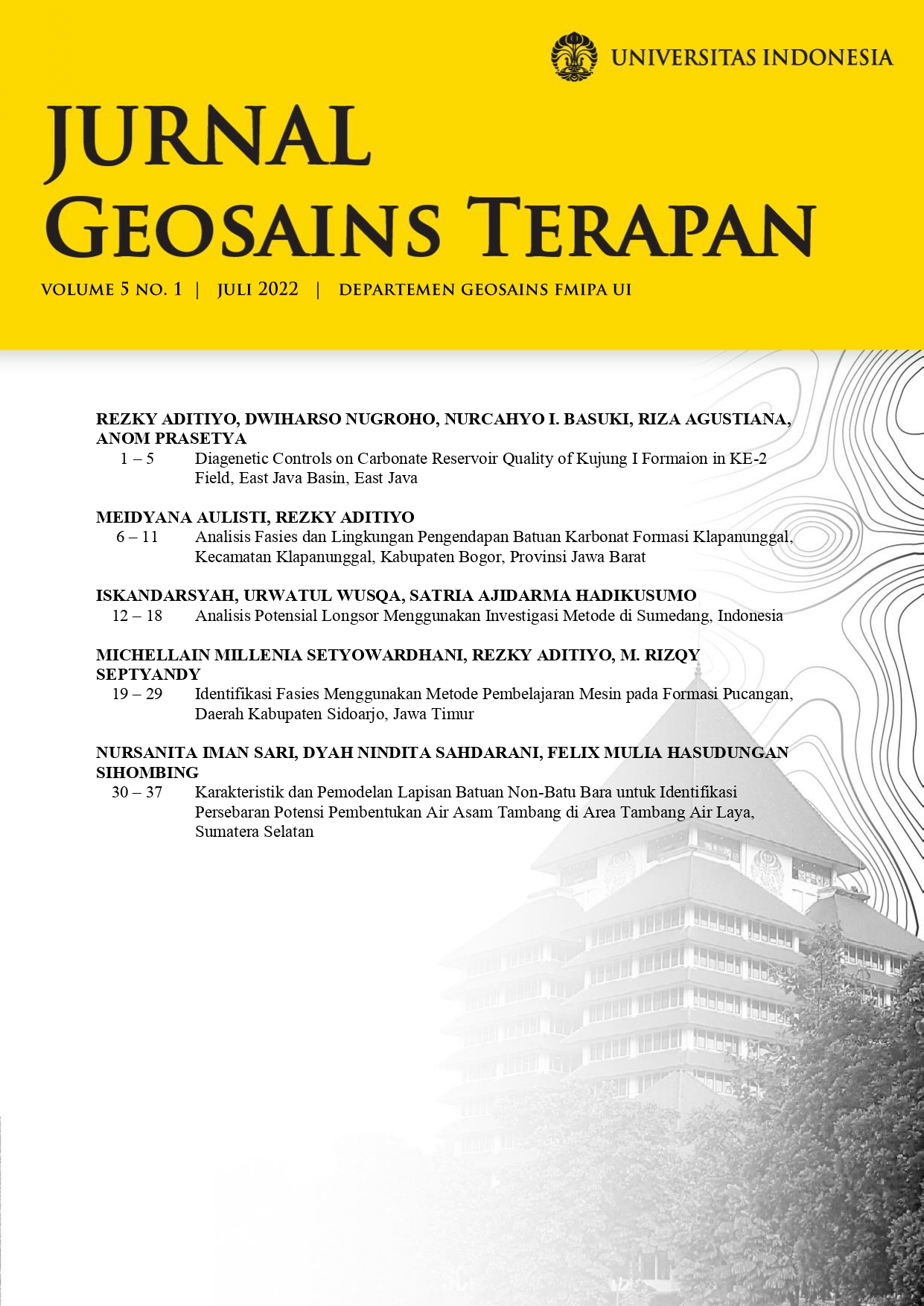Analisis Fasies dan Lingkungan Pengendapan Batuan Karbonat Formasi Klapanunggal, Kecamatan Klapanunggal, Kabupaten Bogor, Provinsi Jawa Barat
Kata Kunci:
Fasies, Formasi Klapanunggal, Batugamping, Foraminifera, Asosiasi FasiesAbstrak
Daerah penelitian terletak pada Formasi Klapanunggal yang berlokasi di Kecamatan Klapanunggal, Kabupaten Bogor, Jawa Barat. Formasi Klapanunggal merupakan salah satu formasi yang mengisi Cekungan Bogor pada umur Miosen Tengah hingga Miosen Akhir dan terdiri atas litologi batugamping. Tujuan dari penelitian ini yaitu mengetahui fasies dan lingkungan pengendapan pada Formasi Klapanunggal selama formasi ini terendapkan. Metode yang digunakan yaitu analisis data lapangam (deskripsi dan measuring section) dan analisis laboratorium (petrografi). Berdasarkan analisis secara lanjut, Formasi Klapanunggal menghasilkan 6 fasies karbonat diantaranya Bioclastic Wackstone (FK 1), Bioclastic Packstone (FK 2), Bioclastic Rudstone (FK 3), Larger Foraminifera Rudstone (FK 4), Larger Foraminifera Grainstone (FK 5), dan Bioclastic Bindstone (FK 6) serta 3 asosiasi fasies lingkungan pengendapan yaitu Platform Margin Reef (AF 1), Platform Interior–Normal Marine (Open Marine) (AF 2), dan Platform Interior–Restricted (AF 3).
Referensi
Amirshahkarami, M. & Karavan, M. (2015). Microfacies models and sequence stratigraphic architecture of the Oligocene–Miocene Qom Formation, south of Qom City, Iran. Geoscience Frontiers 6(4), 593-604.
Banerjee, S., Khanolkar, S. & Saraswati, P.K. (2018). Facies and depositional settings of the Middle Eocene-Oligocene carbonates in Kutch. Geodinamica Acta 30(1), 119-136.
Bassi, L., Boni, E., Dallai, A., Guidi, F., Ricci, S., & Tortoli, P. (2007). 8A-2 ULA-OP: A Novel ULtrasound Advanced Open Platform for Experimental Research. In 2007 IEEE Ultrasonics Symposium Proceedings.
Bondy, S.C. & Purdy, J.L. (1974). Selective regulation of the blood-brain barrier by sensory input. Brain Res 76(3), 542-5.
Boudaugher-Fadel, M.K. (2018). Evolution and geological significance of larger benthic foraminifera. UCL Press.
Corda, L. & Brandano, M. (2003). Aphotic zone carbonate production on a Miocene ramp, Central Apennines, Italy. Sedimentary Geology 161(1-2), 55-70.
Dunham, R.J. (1962). Classification of carbonate rocks according to depositional textures.
Dupraz, C. & Strasser, A. (2002). Nutritional modes in coral—Microbialite reefs (Jurassic, Oxfordian, Switzerland): Evolution of trophic structure as a response to environmental change. Palaios 17(5), 449-471.
Embry, A.F., & Klovan, J.E. (1971). A late Devonian reef tract on northeastern Banks Island, NWT. Bulletin of Canadian Petroleum Geology 19(4), 730-781.
Flügel, E. (1982). Evolution of Triassic reefs: current concepts and problems. Facies 6(1), 297-327.
Flügel, E. (2004). Microfacies data: fabrics. In Microfacies of carbonate rocks. Springer, Berlin, Heidelberg.
Folk, R. L. (1965). Some aspects of recrystallization in ancient limestones.
Geel, T. (2000). Recognition of stratigraphic sequences in carbonate platform and slope deposits: empirical models based on microfacies analysis of paleogene deposits in southeastern Spain. Palaeogeography, Palaeoclimatology, Palaeoecology 155, 211–238.
Habibi, T. (2016). Biostratigraphy, paleoenvironment and foraminiferal associations of the Rupelian-Chattian sediments in Zagros Basin, SW Iran. Journal of African Earth Sciences 123, 370-380.
Hallock, P. & Schlager, W. (1986). Nutrient excess and the demise of coral reefs and carbonate platforms. Palaios, 389-398.
Hussain, M. & Al-Ramadan, K. (2009). Microfacies analysis of Wadi Waqb member (Miocene) in Wadi Aynunah, northwest of Saudi Arabia. Carbonates and Evaporites 24(2), 139-149.
Martodjojo, S. (2003). Evolusi Cekungan Bogor Jawa Barat. Bandung: Penerbit ITB.
Maxwell, W.G.H. (1968). Atlas of the great barrier reef.
Mihaljević, M., Renema, W., Welsh, K. & Pandofki, J. M. (2014). Eocene-Miocene Shallow-water Carbonate Platforms and Increased Habitat Diversity in Sarawak, Malaysia. Palaios 29(7), 378-391.
Novak, V., Santodomingo, N., Rösler, A., Di Martino, E., Braga, J.C., Taylor, P.D. & Renema, W. (2013). Environmental reconstruction of a late Burdigalian (Miocene) patch reef in deltaic deposits (East Kalimantan, Indonesia). Palaeogeography, Palaeoclimatology, Palaeoecology, 374 110-122.
Pomar, L. (2001). Types of carbonate platforms: a genetic approach. Basin research 13(3), 313-334.
Purdy, E.G. (1974). Reef confgurations: cause and efect. In: Laporte LF (ed) Reefs in time and space, vol 18. Society of Economic Paleontologists and Mineralogists, Tulsa, pp 9–76.
Reminton, C.H. & Nasir, H. (1986), Potensial Hidrokarbon Pada Batuan Karbonat Miosen Jawa Barat Utara. PIT IAGI XV, Yogyakarta.
Sallam, E.S. & Ruban, D.A. (2020). Facies analysis and depositional environments of the Miocene syn-rift carbonate–siliciclastic rock packages in the northwest Gulf of Suez, Egypt. Carbonates and Evaporites 35(1), 1-20.
Suyono, K.S. (2005). Exploration In West Java: Play Concepts In The Past, Present And Future, Efforts To Maintain Reserves Growth. Thirtieth Annual Convention & Exhibition, Proceedings, Indonesian Petroleum Association.
Wilson, J. L. (1975). The lower carboniferous Waulsortian facies. In Carbonate facies in geologic history. Springer, New York, NY.
Zamagni, J., Mutti, M. & Košir, A. (2008). Evolution of shallow benthic communities during the Late Paleocene–earliest Eocene transition in the Northern Tethys (SW Slovenia). Facies 54(1), 25-43.
Diterbitkan
Cara Mengutip
Lisensi
Hak Cipta (c) 2022 Jurnal Geosains Terapan

Artikel ini berlisensi Creative Commons Attribution-NonCommercial-NoDerivatives 4.0 International License.


